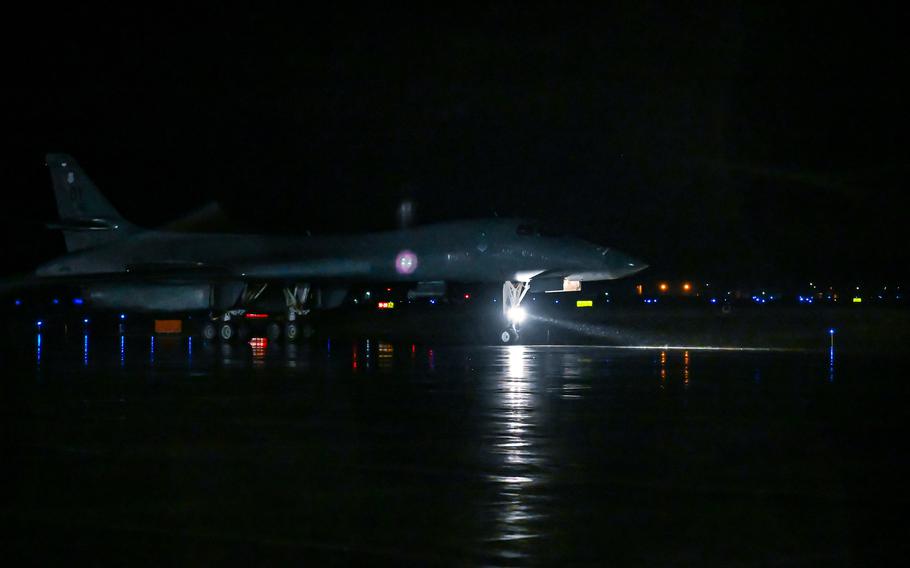
A B-1B Lancer from Dyess Air Force Base, Texas, arrives at Misawa Air Base in northeastern Japan, April 15, 2025. (Mattison Cole/U.S. Air Force)
American B-1B Lancers arrived this week at Misawa Air Base for their first rotational bomber task force mission in Japan, Pacific Air Forces said Tuesday.
The aircraft, along with airmen and support equipment from the 9th Expeditionary Bomb Squadron at Dyess Air Force Base, Texas, landed at the northern Japan air base that day, according to a PACAF news release.
The number of bombers and airmen, as well as the expected duration of their stay, were not cleared for release by PACAF, Capt. LeeRoy Stark, a spokesman for the 35th Fighter Wing at Misawa, said in an email Thursday.
The bomber mission supports strategic deterrence as well as training with allies, partners and joint forces, according to the PACAF statement.
The Air Force routinely deploys Lancers, B-52 Stratofortress bombers and B-2 Spirit stealth bombers around the world on task force missions. The deployments began in January 2018 and have continued regularly since 2020.

A B-1B Lancer from Dyess Air Force Base, Texas, arrives at Misawa Air Base in northeastern Japan, April 15, 2025. (Mattison Cole/U.S. Air Force)
“While the missions for each [bomber task force] may vary, the overall goal remains the same: assure allies and deter adversaries,” says the Air Force Global Strike Command website.
Bomber task force deployments are also intended to familiarize aircrews with bases and operations in various parts of the world.
The mission “showcases the U.S. commitment to deterring threats and maintaining regional stability,” Lt. Col. Christopher Travelstead, director of operations for the 9th Expeditionary Bomb Squadron, said in PACAF’s release.
North Korea threatened unspecified retaliation after U.S B-1B bombers on Tuesday flew over South Korea with South Korean warplanes, the Associated Press reported Thursday.
In February, two Lancers from Andersen Air Force Base, Guam, flew through South Korean airspace alongside three U.S. F-16 Fighting Falcons from Osan Air Base, South Korea; four Marine Corps F-35Bs from Marine Corps Air Station Iwakuni, Japan; and four South Korean F-35As and F-15K Slam Eagles.
In January, Japanese F-2s and South Korean F-15K Slam Eagles escorted a pair of Lancers over the Sea of Japan, also known as the East Sea.
The Air Force has not permanently stationed bombers in Japan for decades, retired Marine Col. Grant Newsham, a senior researcher with the Japan Forum for Strategic Studies, told Stars and Stripes by email Thursday
Yokota Air Base, an airlift hub in western Tokyo, operated as a bomber base before 1971.
Faced with China’s growing military power and regional ambitions, Japan has reinterpreted its pacifist constitution to permit counterstrike capabilities in the event of war.
Despite years of increased defense spending, Japan does not field strategic bombers of its own, Newsham wrote.
“Besides the practical challenges to operating a heavy bomber fleet, there’s the problem that bombers almost by definition are ‘offensive’ weapons — that Japan decided it would not possess,” he said.
Air Force F-16 multirole fighters at Misawa are trained to strike enemy air-defense systems.
“A B-1 (the type that went to Misawa) and B-52s can carry much bigger bomb and missile loads than the F-16s,” Newsham wrote. “And the aircraft have much longer ranges as well than F-16s. B-1s are also reasonably survivable given their stealth capability.”
Deploying heavier, more powerful aircraft sends an implicit message, Newsham added.
“You’re adding to an existing ‘force level’ and implicitly saying that, if necessary, you are going to inflict even more serious harm on the enemy if he misbehaves,” he said.
Rotational deployments also signal to potential adversaries such as North Korea, Russia and China that the U.S. has multiple deployment options, Ralph Cossa, former president of the Pacific Forum think tank in Hawaii, said by email Thursday.